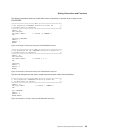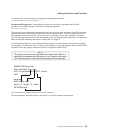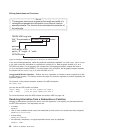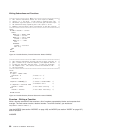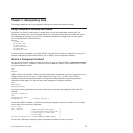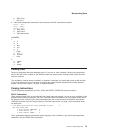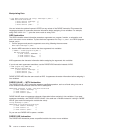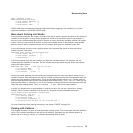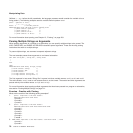
Chapter 7. Manipulating Data
This chapter describes how to use compound variables and stems and explains parsing.
Using Compound Variables and Stems
Sometimes it is useful to store groups of related data in a way that makes data retrieval easy. For
example, you could store a list of employee names in an array and retrieve them by number. An array is
an arrangement of elements in one or more dimensions, identified by a single name. An array called
employee could contain names as follows:
EMPLOYEE
(1) Adams, Joe
(2) Crandall, Amy
(3) Devon, David
(4) Garrison, Donna
(5) Leone, Mary
(6) Sebastian, Isaac
In some computer languages, you use the number of the element to access an element in an array. For
example, employee(1) would retrieve Adams, Joe. In REXX, you use compound variables.
What Is a Compound Variable?
You can use compound variables to create an array or a list of variables in REXX. A compound variable,
for example: employee.1, consists of a stem and a tail. A stem is a symbol with a period at the end. Here
are some examples of stems:
FRED.
Array.
employee.
A tail is similar to a subscript. It follows the stem and consists of additional parts of the name that can be
constant symbols (as in employee.1), simple symbols (as in employee.n), or null. Thus, in REXX,
subscripts need not necessarily be numeric. A compound variable contains at least one period with
characters on both sides of it. Here are some more examples of compound variables:
FRED.5
Array.Row.Col
employee.name.phone
You cannot do any substitution for the name of the stem but you can use substitution for the tail. For
example:
employee.7='Amy Martin'
new=7
employee.new='May Davis'
say employee.7 /* Produces: May Davis */
As with other REXX variables, if you have not previously assigned a value to a variable in a tail, it takes
on the value of its own name in uppercase.
first = 'Fred'
last = 'Higgins'
name = first.last /* NAME is assigned FIRST.Higgins */
/* The value FIRST appears because the */
/* variable FIRST is a stem, which */
/* cannot change. */
SAY name.first.middle.last /* Produces NAME.Fred.MIDDLE.Higgins */
You can use a DO loop to initialize a group of compound variables and set up an array.
© Copyright IBM Corp. 1992, 2009 71



